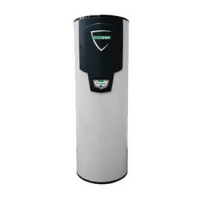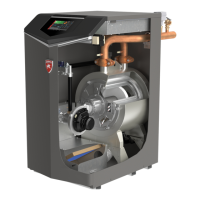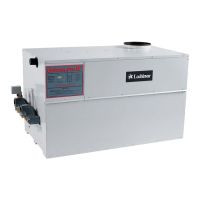12 • Commercial Electric Water Heaters
INSTALLING THE WATER HEATER
The installation must conform with these instructions and the local
code authority having jurisdiction and the requirements of the power
company. In the absence of code requirements, follow NFPA-70
(current edition). In the absence of local codes, the installation must
comply with the latest editions of the National Electrical Code, NFPA
70 or the Canadian Electrical Code CSA C22.1. The National Electrical
Code may be ordered from: National Fire Protection Association, 1
Batterymarch Park, Quincy, MA 02269. The Canadian Electrical Code
is available from the Canadian Standards Association, 8501 East
Pleasant Valley Road, Cleveland, OH 44131.
Note: To comply with NSF Standard 5 installation requirements the
bottom of the water heater must be sealed to the oor with a
silicone based sealant or elevated 6 inches above the oor.
Do NOT test electrical system before heater is lled with water, follow
the procedures in Start Up and Operation (page 17).
The principal components of the heater are identied in Features and
Components (page 8).
Water temperature over 125°F (52°C)
can cause severe burns instantly
resulting in severe injury or death.
Children, the elderly and the
physically or mentally disabled are at
highest risk for scald injury.
Feel water before bathing or shower-
ing.
Temperature limiting devices such as
thermostatic point-of-use mixing
valves must be installed when
required by codes and to ensure safe
temperatures at fixtures.
REQUIRED ABILITY
Installation and service of this water heater requires ability equivalent
to that of a qualied agency (page 2) in the eld involved. See
Important Definitions (page 3). Plumbing and electrical work is
required.
THERMOSTATIC POINT-OF-USE MIXING VALVES
Water heaters are intended to produce hot water. Water heated to
a temperature which will satisfy space heating, clothes washing,
dish washing, cleaning and other sanitizing needs can scald and
permanently injure you upon contact. Some people are more likely
to be permanently injured by hot water than others. These include
the elderly, children, the infirm, or physically/developmentally
disabled. If anyone using hot water in your home ts into one of these
groups or if there is a local code or state law requiring a maximum
water temperature at the hot water tap, then you must take special
precautions.
Table 2 shows the approximate time-to-burn relationship for normal
adult skin.
Table 2. Burn Time at Various Temperatures
Water Temperature
°F (°C)
Time for 1st Degree
Burn
(Less Severe Burns)
Time for Permanent
Burns
2nd & 3rd Degree
(Most Severe Burns)
110 (43) (normal shower temp.)
116 (47) (pain threshold)
116 (47) 35 minutes 45 minutes
122 (50) 1 minute 5 minutes
131 (55) 5 seconds 25 seconds
140 (60) 2 seconds 5 seconds
149 (65) 1 second 2 seconds
154 (68) instantaneous 1 second
(U.S. Government Memorandum, C.P.S.C., Peter L. Armstrong, Sept. 15, 1978)
Burn Hazard
If you choose a higher temperature
setting, install thermostatic mixing
valves at each point-of-use to help
avoid scalding.
Burn Hazard
To reduce the risk of unusually hot
water reaching the fixtures in the
house, install thermostatic mixing
valves at each point of use.
In addition to using the lowest possible temperature setting that
satises your hot water needs, a means such as a mixing valve
can be used at the water heater or the hot water taps used by
these people or at the water heater.
Check State and/or local codes for mixing valve requirements and
installation practices.
Thermostatic Point-of-Use Mixing Valves for reducing point of
use temperature are available. Consult a qualied installer or service
agency. Follow all manufacturer’s Instructions for installation of these
valves. Before changing the factory setting on the thermostat, read
Temperature Regulation (page 18).
Toxic Chemical Hazard
● Do not connect to non-potable water system.
CONTAMINATED WATER
This water heater shall not be connected to any heating system(s)
or component(s) used with a non-potable water heating appliance.
Toxic chemicals, such as those used for boiler treatment shall not
be introduced into this system.

